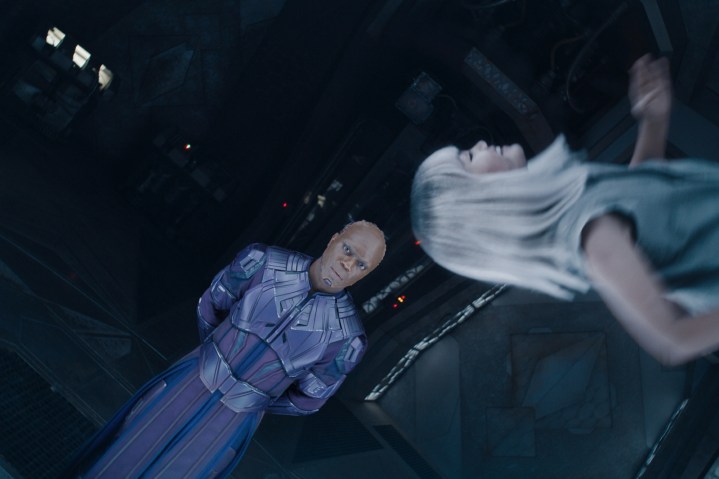Nowadays, it’s not all that controversial to say that the Marvel Cinematic Universe has been stuck in a bit of a rut for the past few years. In the wake of the climactic high that it hit with 2019’s Avengers: Endgame, Marvel has repeatedly struggled to consistently deliver films and TV shows that feel as cohesive as the titles that built up the studio’s reputation in the first place. That hasn’t been due to a lack of trying, either. In just the past four years, Marvel has released around 20 new feature films and Disney+ MCU shows.
While opinions may vary about the MCU’s latest offering, Guardians of the Galaxy Vol. 3, the general consensus surrounding the James Gunn-directed film seems fairly positive right now. At the very least, many seem to agree that it’s the first MCU film in quite a while that feels like it was actually made with real, palpable amounts of love and passion. It also, notably, introduces the most memorable and compelling villain who has shown up in the MCU since Josh Brolin’s Thanos was dusted out of existence in Endgame.
The villain in question? A mad scientist known as the High Evolutionary, who is played with zealous intensity by Peacemaker star Chukwudi Iwuji.

Guardians of the Galaxy Vol. 3 makes it clear in its opening moments that the film is, among other things, an exploration of Bradley Cooper’s Rocket Raccoon. The film specifically focuses on the character’s tortured past, which has been hinted at but never actually shown or explored in Gunn’s previous Guardians of the Galaxy efforts. Vol. 3 features multiple flashbacks to Rocket’s time with the High Evolutionary, whose obsession with genetic evolution led him to torture, mutate, and experiment on countless animals and living beings, including Rocket.
Through the film’s flashback sequences, viewers discover just how much physical, mental, and emotional pain Rocket suffered at the hands of the High Evolutionary. They also learn that the hatred present in the villain’s relationship with Rocket isn’t just one-sided. In an odd, darkly compelling twist of fate, it’s revealed that the High Evolutionary grew to hate and resent Rocket not because of any defects or imperfections, but because of his intellect, which greatly exceeded his own.
After Rocket solves a problem that had previously stumped him and his assistants, Iwuji’s High Evolutionary is filled with both exhilaration over his latest achievement and fury over the fact that it was one of his own creations who made the breakthrough in the first place. In response, the High Evolutionary facilitates the execution of Rocket’s only friends — a trio of animals who had been similarly experimented on. Altogether, these moments create a wrathful storm of emotions between Rocket and the High Evolutionary that’s not only surprisingly powerful but also deeply, deeply personal.

Guardians of the Galaxy Vol. 3 takes an important lesson out of its 2017 predecessor’s playbook. Much like that film, which pitted Chris Pratt’s Peter Quill against his own father, Vol. 3 mines incredible drama out of the impending reunion between Rocket and his Machiavellian creator.
As he himself points out, the High Evolutionary isn’t just another wannabe world conqueror. He is drawn to the Guardians solely by his desire to kill Rocket, and they are, conversely, pulled to him by their desire to save their furry friend. Consequently, when Pratt’s Peter stands before the High Evolutionary with clear venom in his eyes, it’s easy to get wrapped up in the emotions of their confrontation solely because of how personal the stakes of Vol. 3’s story feel. By establishing a specific and unique relationship between its villain and heroes, the film is able to ensure that the former feels anything but generic.
The impactfulness of the High Evolutionary’s role in Guardians of the Galaxy Vol. 3 is also due to Iwuji’s scene-stealing performance as the character. The High Evolutionary is a mad scientist with a literal god complex, and Iwuji spends most of the film leaning all the way into that. Whether it be the austere edge he adds to the character’s British accent or the way that he always seems to keep his chain raised and his back as straight as possible, Iwuji ensures that the vanity of his MCU villain is always, unavoidably clear. That aspect of his performance only makes the moments when the High Evolutionary devolves into his own childish, selfish tantrums all the more jarring and frightening.

Guardians of the Galaxy Vol. 3 is far from a perfect movie. As is usually the case in the MCU, the film is about as subtle as a siren and a bit too long for its own good. That said, it’s hard to find many flaws with its villain. Not only is the High Evolutionary a well-performed and formidable foe, but he’s also a perfect antagonist for the Guardians themselves.
Over the course of their adventures together, the fan-favorite MCU group has learned to accept and love each other for who they are, flaws and all. Taking that into account, what better villain could there be for the Guardians to face on their final mission together than one who is obsessed with erasing the imperfections present in all of us? The High Evolutionary is the antithesis of everything the Guardians believe and represent.
To its credit, Guardians of the Galaxy Vol. 3 uses that inherent conflict to secure the High Evolutionary a place as one of the best villains in the history of the MCU.
Guardians of the Galaxy Vol. 3 is now playing in theaters.



